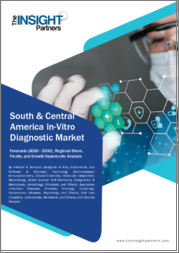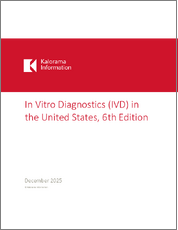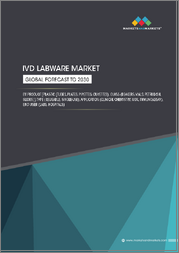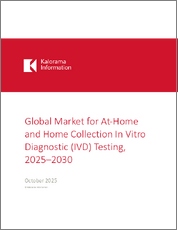
|
시장보고서
상품코드
1463557
중남미 체외 진단 시장 : 지역 분석 - 제품 및 서비스, 기술, 용도, 최종 사용자별 예측(-2030년)South & Central America In-Vitro Diagnostics Market Forecast to 2030 - Regional Analysis - by Product & Services, Technology, Application, and End User |
||||||
중남미 체외 진단 시장은 2022년 58억 7,417만 달러에서 2030년에는 84억 7,811만 달러로 성장할 것으로 예측됩니다. 예측기간 동안 복합 연간 성장률(CAGR) 4.7%로 추정됩니다.
IVD 기술과 디지털 헬스 솔루션의 통합이 중남미 체외 진단 시장을 뒷받침
체외 진단은 임상, 실험실 및 외래에서 사용되며, 특히 질병의 발견에 도움이 되므로 적절한 치료 프로토콜을 선택하는 데 도움이 됩니다. IVD 기술과 디지털 헬스 솔루션의 통합은 세계적으로 견인력을 증가시키고 있습니다. 데이터 분석, 인공지능 및 원격 모니터링은 진단 검사의 가치를 높여 환자 관리와 결과를 개선합니다. 디지털 건강 솔루션과 통합된 체외 진단용 의약품 기술은 임상 의사 결정 지원 시스템에 통합될 수 있습니다. WHO가 알고 있듯이 디지털 건강 솔루션은 질병을 발견하는 데 도움이 될 수 있습니다. 인공지능을 이용한 건강 봇 및 기타 유사한 새로운 솔루션은 환자 관리에 기회를 제공하여 고비용 및 시간 요구 사항과 같은 과제를 해결할 수 있습니다. 게놈 검사를 기반으로 한 진단에서 딥러닝은 특정 샘플의 이미지에서 암세포를 확인하고 유형을 결정하며 종양에 어떤 돌연변이가 발생하는지 예측할 수 있습니다. 체외 진단에 있어서의 인공지능과 머신러닝(AI/ML)은 의료기기 개발에 혁명을 가져오고 있습니다. 이러한 최신 진단 시스템은 디지털 이미지 분석을 기반으로 진단을 용이하게 하여 건강 관리 의사 결정을 개선합니다. 스마트 진단제는 인공지능을 활용하여 실험실 기반 진단제보다 우수한 성능을 약간의 가격으로 실현하는 매우 확장성이 높은 체외 진단 솔루션입니다. 게다가, 이러한 유형의 진단제는 독자적인 화학적 및 생물학적 시그니처의 검출과 분석을 통해 창의적인 특징을 도출할 수 있습니다. 따라서 체외 진단과 디지털 건강 기술의 통합은 앞으로 몇 년동안 체외 진단 시장에 유리한 기회를 제공 할 가능성이 높습니다.
중남미 체외 진단 시장 개요
중남미 체외 진단 시장은 브라질, 아르헨티나 및 기타 남미로 구분됩니다. 이 지역의 체외 진단 시장은 만성 질환의 유병률이 높고, 진단 시설 증가, 신흥국 시장의 헬스 케어 인프라의 발전에 의해 예측 기간 중의 성장이 전망되고 있습니다. 중남미에서의 체외 진단 시장의 성장에는 앞서 언급한 요인이 영향을 받고 있습니다. 브라질은 중남미 최대 시장입니다. 지원 정부, 유리한 건강 관리 정책, 신흥 경제 국가, 첨단 건강 관리 인프라 등의 요인은 진단에 최신 기술을 채택할 여지를 창출하고 있습니다. 게다가 만성질환과 감염증의 유행이 증가하고 있는 것도 이 나라의 체외진단 시장의 성장을 가속할 것으로 예측되며 있습니다. 국제 당뇨병 연합이 발표한 조사에 따르면 브라질의 당뇨병 인구는 2021년 1,570만명에서 2045년에는 2,180만명에 이를 것으로 예측됩니다. 또한 추계에 따르면 브라질의 당뇨병 인구는 세계 5위입니다. 체외 진단 시장의 선도 기업 중 상당수는 브라질의 지리적 확장을 통해 시장을 강화하는 전략적 이니셔티브를 취하고 있습니다. 예를 들어, 2022년 8월, 프레제니우스 곰팡이는 Bio-Manguinhos/Fiocruz 및 Bionovis와 제휴하여 브라질에서 아달리무맙의 바이오시밀러에 대한 액세스를 제공합니다. 이 제휴는 브라질의 공공 의료 시스템(SUS)에서 여러 자가 면역 질환의 치료 옵션을 확장합니다.
또한 브라질은 노인 인구의 높은 증가율을 목격하고 있습니다. 예를 들어, 범미 보건기구(Pan American Health Organization)에 따르면, 브라질의 60세 이상의 노인은 3,000만 명을 넘었으며, 이는 이 나라의 인구의 13%에 해당합니다. 맞춤형 의료의 개발,실시에 있어서의 분자진단 기술의 활용은 브라질 시장의 성장을 뒷받침할 것으로 예상됩니다. 2020년 2월 28일, 세파이드와 셜록 바이오사이언시스는 새로운 최첨단 분자진단 검사의 개발을 모색하기 위해 제휴했습니다. 이 제휴는 종양 질환 및 감염에 대한 분자진단 검사의 개발에 중점을 둡니다. 브라질은 라틴아메리카 최대의 건강 관리 시장으로 GDP의 9.1%를 건강 관리에 소비하고 있습니다. 2021년 브라질은 의료기기 수입을 7.3% 늘리고 62억 달러에 달할 전망입니다. 브라질 정부는 건강 관리 제품의 주요 구매자이며 공공 의료 시스템에 제품을 공급하고 있습니다. 국제무역국에 따르면 2021년에는 3억 1,700만 달러의 CBDL 체외 진단용 시약,기기가 브라질에 수입되었습니다. 이처럼 신흥경제국가와 당뇨병 만연의 확대는 브라질의 체외진단 시장의 성장을 뒷받침하고 있습니다.
중남미 체외진단시장 수익과 예측(-2030년)(금액)
중남미 체외 진단 시장 세분화
중남미 체외 진단 시장은 제품 및 서비스, 기술, 용도, 최종 사용자, 국가로 구분됩니다.
제품 및 서비스별로 중남미 체외 진단 시장은 시약 및 키트, 장비, 소프트웨어 및 서비스로 구분됩니다. 2022년 중남미 체외 진단 시장에서 시약 및 키트 부서는 가장 큰 점유율을 차지합니다.
기술별로 중남미 체외진단 시장은 면역측정/면역화학, 임상화학, 분자진단, 미생물학, 혈당자가측정, 응고,지혈, 혈액학, 소변검사 등으로 구분됩니다. 2022년 중남미 체외 진단 시장에서는 면역 측정/면역화학 분야가 가장 큰 점유율을 차지했습니다.
용도별로 중남미 체외 진단 시장은 감염증, 당뇨병, 종양, 심장병, 자가면역질환, 신장병 등으로 구분됩니다. 2022년 중남미 체외 진단 시장에서는 전염병 분야가 가장 큰 점유율을 차지합니다.
최종 사용자별로 보면 중남미 체외 진단 시장은 병원, 연구소, 재택치료, 기타로 구분됩니다. 병원 부문은 2022년 중남미 체외 진단 시장에서 가장 큰 점유율을 차지합니다.
국가별로 중남미 체외 진단 시장은 브라질, 아르헨티나 및 기타 남미로 구분됩니다. 2022년 중남미 체외 진단 시장은 브라질이 독점.
Abbott Laboratories, Becton Dickinson and Co, bioMerieux SA, Bio-Rad Laboratories Inc, Danaher Corp, F. Hoffmann-La Roche Ltd, Qiagen NV, Siemens AG, Sysmex Corp, Thermo Fisher Scientific Inc는 남미 및 중남미 체외 진단 시장 에 참가하는 대기업입니다.
목차
제1장 서론
제2장 주요 요약
- 주요 인사이트
제3장 조사 방법
- 조사 범위
- 2차 조사
- 1차 조사
제4장 중남미 체외 진단 시장- 주요 산업역학
- 시장 성장 촉진요인
- 만성 질환 및 감염증의 유병률 증가
- 포인트 오브 케어 검사의 성장과 COVID-19 팬데믹시의 체외 진단 수요의 급증
- 시장 성장 억제요인
- 규제 체제와 상환 정책의 미비
- 시장 기회
- IVD와 디지털 헬스 기술의 통합
- 향후의 동향
- 맞춤형 의료와 유전체학에 대한 수요 증가
제5장 임상 검사 시장 : 중남미 시장 분석
- 중남미 체외 진단 시장 수익(2022년-2030년)
제6장 남미?중미의 체외 진단 시장 : 수익과 예측(-2030년) : 제품?서비스별
- 시장수익 점유율(2022년, 2030년)
- 시약 및 키트
- 소프트웨어 및 서비스
- 검사기기
제7장 남미,중미의 체외 진단 시장 : 수익과 예측(-2030년) : 기술별
- 시장수익 점유율(2022년, 2030년)
- 면역측정/면역화학
- 임상 화학
- 분자진단학
- 미생물학
- 혈당 자기 측정
- 응고 및 지혈
- 혈액학
- 소변 검사
- 기타
제8장 중남미 체외 진단 시장 : 수익과 예측(-2030년) : 용도별
- 시장수익 점유율(2022년, 2030년)
- 감염증
- 당뇨병
- 종양학
- 순환기
- 자가면역질환
- 신장내과
- 기타
제9장 중남미 체외 진단 시장 : 수익과 예측(-2030년) : 최종 사용자별
- 시장수익 점유율(2022년, 2030년)
- 병원
- 연구소
- 재택치료
- 기타
제10장 중남미 체외 진단 시장 : 수익과 예측(-2030년) : 국가별 분석
- 브라질
- 아르헨티나
- 기타 중남미
제11장 업계 정세
- 유기적 개발
- 무기적 전개
제12장 기업 프로파일
- Abbott Laboratories
- F. Hoffmann-La Roche Ltd
- Danaher Corp
- Siemens AG
- Sysmex Corp
- Thermo Fisher Scientific Inc
- Becton Dickinson and Co
- bioMerieux SA
- Bio-Rad Laboratories Inc
- Qiagen NV
제13장 부록
BJH 24.05.23The South & Central America in-vitro diagnostics market is expected to grow from US$ 5,874.17 million in 2022 to US$ 8,478.11 million by 2030. It is estimated to grow at a CAGR of 4.7% from 2022 to 2030.
Integration of IVD Technologies with Digital Health Solutions Fuels South & Central America In-Vitro Diagnostics Market
IVD is used in clinical, laboratory, and outpatient settings with the aim specifically to help in the detection of diseases and, consequently, aid in the selection of appropriate treatment protocols. The integration of IVD technologies with digital health solutions is gaining traction globally. Data analytics, artificial Intelligence, and remote monitoring enhance the value of diagnostic tests, leading to better patient management and outcomes. IVD technologies integrated with digital health solutions can be incorporated into clinical decision support systems. As recognized by the WHO, digital health solutions could help detect diseases. Artificial intelligence health bots and similar other emerging solutions may present opportunities for patient care and address challenges such as high cost and time requirements. In diagnostics based on genomic testing, deep learning can identify cancer cells, determine their type, and predict what mutations may occur in a tumor from images of a specific sample. Artificial intelligence and machine learning (AI/ML) in in-vitro diagnostics are revolutionizing medical device development. These modern diagnostic systems facilitate diagnosis based on digital image analysis, thereby improving healthcare decision-making. Smart diagnostics are extremely scalable IVD solutions that use artificial intelligence to perform better than lab-based diagnostics at a fraction of the price. Additionally, this type of diagnostics can derive emergent features through unique chemical and biological signature detection and analysis. Thus, the integration of IVD with digital health technologies is likely to offer lucrative opportunities to the in-vitro diagnostics market in the coming years.
South & Central America In-Vitro Diagnostics Market Overview
The South & Central America in-vitro diagnostics market has been segmented into Brazil, Argentina, and the Rest of South & Central America. The market for in-vitro diagnostics in the region is expected to grow during the forecast period owing to the higher prevalence of chronic conditions, increasing number of diagnostic facilities, and developing healthcare infrastructure. The aforementioned factors are responsible for influential growth of in-vitro diagnostics market in the South & Central America region. Brazil is the largest market in South & Central America. Factors such as supportive government, lucrative healthcare policies, a developing economy, and advancing healthcare infrastructure create scope for adopting modern technologies in diagnostics. Additionally, the increasing prevalence of chronic conditions and infectious diseases is projected to drive the growth of the in-vitro diagnostics market in the country. According to a study published by the International Diabetes Federation, the diabetic population of the country is projected to reach 21.8 million by 2045 from 15.7 million in 2021. Also, according to the estimates, Brazil has the fifth largest diabetic population in the world. A number of major players in the in-vitro diagnostics market take strategic initiatives to consolidate their market through geographic expansions in Brazil. For instance, in August 2022, Fresenius Kabi partnered with Bio-Manguinhos/Fiocruz and Bionovis to provide access to adalimumab biosimilar in Brazil. This partnership will expand treatment options for several autoimmune diseases in the Brazilian Public Health System (SUS).
Additionally, Brazil is witnessing a high rate of growth in the geriatric population. For instance, according to the Pan American Health Organization, Brazil has more than 30 million people aged 60 years or more, which represents 13% of the country's population. The use of molecular diagnostic techniques in developing and, subsequently, administering personalized medicine is likely to boost the market growth in Brazil. On February 28, 2020, Cepheid and Sherlock Biosciences collaborated to explore the development of new cutting-edge molecular diagnostic tests. The collaboration will focus on the development of molecular diagnostic tests for oncological conditions and infectious diseases. Brazil is the largest healthcare market in Latin America, spending 9.1% of its GDP on healthcare. In 2021, Brazil added the imports of medical devices by 7.3%, reaching US$ 6.2 billion. The Government of Brazil is a key buyer of healthcare products, which supply them to the public healthcare system. As per the International Trade Administration ~US$ 317 million CBDL in vitro diagnostic reagents and equipment were imported into Brazil in 2021. Thus, the developing economy and growing diabetes prevalence fuels the in-vitro diagnostics market growth in Brazil.
South & Central America In-Vitro Diagnostics Market Revenue and Forecast to 2030 (US$ Million)
South & Central America In-Vitro Diagnostics Market Segmentation
The South & Central America in-vitro diagnostics market is segmented into product & services, technology, application, end user, and country.
Based on product & services, the South & Central America in-vitro diagnostics market is segmented into reagents & kits, instruments, and software & services. The reagents & kits segment held the largest share of the South & Central America in-vitro diagnostics market in 2022.
Based on technology, the South & Central America in-vitro diagnostics market is segmented into immunoassay/ immunochemistry, clinical chemistry, molecular diagnostics, microbiology, blood glucose self-monitoring, coagulation & hemostasis, hematology, urinalysis, and others. The immunoassay/ immunochemistry segment held the largest share of the South & Central America in-vitro diagnostics market in 2022.
Based on application, the South & Central America in-vitro diagnostics market is segmented into infectious diseases, diabetes, oncology, cardiology, autoimmune diseases, nephrology, and others. The infectious diseases segment held the largest share of the South & Central America in-vitro diagnostics market in 2022.
Based on end user, the South & Central America in-vitro diagnostics market is segmented into hospitals, laboratories, homecare, and others. The hospitals segment held the largest share of the South & Central America in-vitro diagnostics market in 2022.
Based on country, the South & Central America in-vitro diagnostics market is segmented int o Brazil, Argentina, and the Rest of South & Central America. Brazil dominated the South & Central America in-vitro diagnostics market in 2022.
Abbott Laboratories, Becton Dickinson and Co, bioMerieux SA, Bio-Rad Laboratories Inc, Danaher Corp, F. Hoffmann-La Roche Ltd, Qiagen NV, Siemens AG, Sysmex Corp, and Thermo Fisher Scientific Inc are some of the leading companies operating in the South & Central America in-vitro diagnostics market.
Table Of Contents
1. Introduction
- 1.1 The Insight Partners Research Report Guidance
- 1.2 Market Segmentation
2. Executive Summary
- 2.1 Key Insights
3. Research Methodology
- 3.1 Coverage
- 3.2 Secondary Research
- 3.3 Primary Research
4. South & Central America In-Vitro Diagnostics Market - Key Industry Dynamics
- 4.1 Key Market Drivers
- 4.1.1 Increasing Prevalence of Chronic and Infectious Diseases
- 4.1.2 Growth in Point-of-Care Testing and Surge in Demand for IVD during COVID-19 Pandemic
- 4.2 Market Restraint
- 4.2.1 Insufficiency of Regulatory Frameworks and Reimbursement Policies
- 4.3 Market Opportunities
- 4.3.1 Integration of IVD with Digital Health Technologies
- 4.4 Future Trends
- 4.4.1 Increasing Demand for Personalized Medicine and Genomics
5. In-Vitro Diagnostics Market - South & Central America Market Analysis
- 5.1 South & Central America In-Vitro Diagnostics Market Revenue (US$ Mn), 2022 - 2030
6. South & Central America In-Vitro Diagnostics Market - Revenue and Forecast to 2030 - by Product and Services
- 6.1 Overview
- 6.2 South & Central America In-Vitro Diagnostics Market Revenue Share, by Product and Services 2022 & 2030 (%)
- 6.3 Reagents and Kits
- 6.3.1 Overview
- 6.3.2 Reagents and Kits: South & Central America In-Vitro Diagnostics Market - Revenue and Forecast to 2030 (US$ Million)
- 6.4 Software and Services
- 6.4.1 Overview
- 6.4.2 Software and Services: South & Central America In-Vitro Diagnostics Market - Revenue and Forecast to 2030 (US$ Million)
- 6.5 Instruments
- 6.5.1 Overview
- 6.5.2 Instruments: South & Central America In-Vitro Diagnostics Market - Revenue and Forecast to 2030 (US$ Million)
7. South & Central America In-Vitro Diagnostics Market - Revenue and Forecast to 2030 - by Technology
- 7.1 Overview
- 7.2 South & Central America In-Vitro Diagnostics Market Revenue Share, by Technology 2022 & 2030 (%)
- 7.3 Immunoassay/ Immunochemistry
- 7.3.1 Overview
- 7.3.2 Immunoassay/ Immunochemistry: South & Central America In-Vitro Diagnostics Market - Revenue and Forecast to 2030 (US$ Million)
- 7.4 Clinical Chemistry
- 7.4.1 Overview
- 7.4.2 Clinical Chemistry: South & Central America In-Vitro Diagnostics Market - Revenue and Forecast to 2030 (US$ Million)
- 7.5 Molecular Diagnostics
- 7.5.1 Overview
- 7.5.2 Molecular Diagnostics: South & Central America In-Vitro Diagnostics Market - Revenue and Forecast to 2030 (US$ Million)
- 7.6 Microbiology
- 7.6.1 Overview
- 7.6.2 Microbiology: South & Central America In-Vitro Diagnostics Market - Revenue and Forecast to 2030 (US$ Million)
- 7.7 Blood Glucose Self-Monitoring
- 7.7.1 Overview
- 7.7.2 Blood Glucose Self-Monitoring: South & Central America In-Vitro Diagnostics Market - Revenue and Forecast to 2030 (US$ Million)
- 7.8 Coagulation and Hemostasis
- 7.8.1 Overview
- 7.8.2 Coagulation and Hemostasis: South & Central America In-Vitro Diagnostics Market - Revenue and Forecast to 2030 (US$ Million)
- 7.9 Hematology
- 7.9.1 Overview
- 7.9.2 Hematology: South & Central America In-Vitro Diagnostics Market - Revenue and Forecast to 2030 (US$ Million)
- 7.10 Urinalysis
- 7.10.1 Overview
- 7.10.2 Urinalysis: South & Central America In-Vitro Diagnostics Market - Revenue and Forecast to 2030 (US$ Million)
- 7.11 Others
- 7.11.1 Overview
- 7.11.2 Others: South & Central America In-Vitro Diagnostics Market - Revenue and Forecast to 2030 (US$ Million)
8. South & Central America In-Vitro Diagnostics Market - Revenue and Forecast to 2030 - by Application
- 8.1 Overview
- 8.2 South & Central America In-Vitro Diagnostics Market Revenue Share, by Application 2022 & 2030 (%)
- 8.3 Infectious Disease
- 8.3.1 Overview
- 8.3.2 Infectious Diseases: South & Central America In-Vitro Diagnostics Market - Revenue and Forecast to 2030 (US$ Million)
- 8.4 Diabetes
- 8.4.1 Overview
- 8.4.2 Diabetes: South & Central America In-Vitro Diagnostics Market - Revenue and Forecast to 2030 (US$ Million)
- 8.5 Oncology
- 8.5.1 Overview
- 8.5.2 Oncology: South & Central America In-Vitro Diagnostics Market - Revenue and Forecast to 2030 (US$ Million)
- 8.6 Cardiology
- 8.6.1 Overview
- 8.6.2 Cardiology: South & Central America In-Vitro Diagnostics Market - Revenue and Forecast to 2030 (US$ Million)
- 8.7 Autoimmune Diseases
- 8.7.1 Overview
- 8.7.2 Autoimmune Diseases: South & Central America In-Vitro Diagnostics Market - Revenue and Forecast to 2030 (US$ Million)
- 8.8 Nephrology
- 8.8.1 Overview
- 8.8.2 Nephrology: South & Central America In-Vitro Diagnostics Market - Revenue and Forecast to 2030 (US$ Million)
- 8.9 Others
- 8.9.1 Overview
- 8.9.2 Others: South & Central America In-Vitro Diagnostics Market - Revenue and Forecast to 2030 (US$ Million)
9. South & Central America In-Vitro Diagnostics Market - Revenue and Forecast to 2030 - by End User
- 9.1 Overview
- 9.2 South & Central America In-Vitro Diagnostics Market Revenue Share, by End User 2022 & 2030 (%)
- 9.3 Hospitals
- 9.3.1 Overview
- 9.3.2 Hospitals: South & Central America In-Vitro Diagnostics Market - Revenue and Forecast to 2030 (US$ Million)
- 9.4 Laboratories
- 9.4.1 Overview
- 9.4.2 Laboratories: South & Central America In-Vitro Diagnostics Market - Revenue and Forecast to 2030 (US$ Million)
- 9.5 Homecare
- 9.5.1 Overview
- 9.5.2 Homecare: South & Central America In-Vitro Diagnostics Market - Revenue and Forecast to 2030 (US$ Million)
- 9.6 Others
- 9.6.1 Overview
- 9.6.2 Others: South & Central America In-Vitro Diagnostics Market - Revenue and Forecast to 2030 (US$ Million)
10. South & Central America In-Vitro Diagnostics Market - Revenue and Forecast to 2030 - Country Analysis
- 10.1 South & Central America In-Vitro Diagnostics Market
- 10.1.1 Overview
- 10.1.2 South & Central America In-Vitro Diagnostics Market, by Country
- 10.1.2.1 Brazil: South & Central America In-Vitro Diagnostics Market - Revenue and Forecast to 2030 (US$ Million)
- 10.1.2.1.1 Overview
- 10.1.2.1.2 Brazil: South & Central America In-Vitro Diagnostics Market - Revenue and Forecast to 2030 (US$ Million)
- 10.1.2.1.3 Brazil: South & Central America In-Vitro Diagnostics Market, by Product and Services, 2020-2030 (US$ Million)
- 10.1.2.1.4 Brazil: South & Central America In-Vitro Diagnostics Market, by Technology, 2020-2030 (US$ Million)
- 10.1.2.1.5 Brazil: South & Central America In-Vitro Diagnostics Market, by Application, 2020-2030 (US$ Million)
- 10.1.2.1.6 Brazil: South & Central America In-Vitro Diagnostics Market, by End User, 2020-2030 (US$ Million)
- 10.1.2.2 Argentina: South & Central America In-Vitro Diagnostics Market - Revenue and Forecast to 2030 (US$ Million)
- 10.1.2.2.1 Overview
- 10.1.2.2.2 Argentina: South & Central America In-Vitro Diagnostics Market - Revenue and Forecast to 2030 (US$ Million)
- 10.1.2.2.3 Argentina: South & Central America In-Vitro Diagnostics Market, by Product and Services, 2020-2030 (US$ Million)
- 10.1.2.2.4 Argentina: South & Central America In-Vitro Diagnostics Market, by Technology, 2020-2030 (US$ Million)
- 10.1.2.2.5 Argentina: South & Central America In-Vitro Diagnostics Market, by Application, 2020-2030 (US$ Million)
- 10.1.2.2.6 Argentina: South & Central America In-Vitro Diagnostics Market, by End User, 2020-2030 (US$ Million)
- 10.1.2.3 Rest of South & Central America: South & Central America In-Vitro Diagnostics Market - Revenue and Forecast to 2030 (US$ Million)
- 10.1.2.3.1 Overview
- 10.1.2.3.2 Rest of South & Central America: South & Central America In-Vitro Diagnostics Market - Revenue and Forecast to 2030 (US$ Million)
- 10.1.2.3.3 Rest of South & Central America: South & Central America In-Vitro Diagnostics Market, by Product and Services, 2020-2030 (US$ Million)
- 10.1.2.3.4 Rest of South & Central America: South & Central America In-Vitro Diagnostics Market, by Technology, 2020-2030 (US$ Million)
- 10.1.2.3.5 Rest of South & Central America: South & Central America In-Vitro Diagnostics Market, by Application, 2020-2030 (US$ Million)
- 10.1.2.3.6 Rest of South & Central America: South & Central America In-Vitro Diagnostics Market, by End User, 2020-2030 (US$ Million)
- 10.1.2.1 Brazil: South & Central America In-Vitro Diagnostics Market - Revenue and Forecast to 2030 (US$ Million)
11. Industry Landscape
- 11.1 Organic Developments
- 11.1.1 Overview
- 11.2 Inorganic Developments
- 11.2.1 Overview
12. Company Profiles
- 12.1 Abbott Laboratories
- 12.1.1 Key Facts
- 12.1.2 Business Description
- 12.1.3 Products and Services
- 12.1.4 Financial Overview
- 12.1.5 SWOT Analysis
- 12.1.6 Key Developments
- 12.2 F. Hoffmann-La Roche Ltd
- 12.2.1 Key Facts
- 12.2.2 Business Description
- 12.2.3 Products and Services
- 12.2.4 Financial Overview
- 12.2.5 SWOT Analysis
- 12.2.6 Key Developments
- 12.3 Danaher Corp
- 12.3.1 Key Facts
- 12.3.2 Business Description
- 12.3.3 Products and Services
- 12.3.4 Financial Overview
- 12.3.5 SWOT Analysis
- 12.3.6 Key Developments
- 12.4 Siemens AG
- 12.4.1 Key Facts
- 12.4.2 Business Description
- 12.4.3 Products and Services
- 12.4.4 Financial Overview
- 12.4.5 SWOT Analysis
- 12.4.6 Key Developments
- 12.5 Sysmex Corp
- 12.5.1 Key Facts
- 12.5.2 Business Description
- 12.5.3 Products and Services
- 12.5.4 Financial Overview
- 12.5.5 SWOT Analysis
- 12.5.6 Key Developments
- 12.6 Thermo Fisher Scientific Inc
- 12.6.1 Key Facts
- 12.6.2 Business Description
- 12.6.3 Products and Services
- 12.6.4 Financial Overview
- 12.6.5 SWOT Analysis
- 12.6.6 Key Developments
- 12.7 Becton Dickinson and Co
- 12.7.1 Key Facts
- 12.7.2 Business Description
- 12.7.3 Products and Services
- 12.7.4 Financial Overview
- 12.7.5 SWOT Analysis
- 12.7.6 Key Developments
- 12.8 bioMerieux SA
- 12.8.1 Key Facts
- 12.8.2 Business Description
- 12.8.3 Products and Services
- 12.8.4 Financial Overview
- 12.8.5 SWOT Analysis
- 12.8.6 Key Developments
- 12.9 Bio-Rad Laboratories Inc
- 12.9.1 Key Facts
- 12.9.2 Business Description
- 12.9.3 Products and Services
- 12.9.4 Financial Overview
- 12.9.5 SWOT Analysis
- 12.9.6 Key Developments
- 12.10 Qiagen NV
- 12.10.1 Key Facts
- 12.10.2 Business Description
- 12.10.3 Products and Services
- 12.10.4 Financial Overview
- 12.10.5 SWOT Analysis
- 12.10.6 Key Developments
13. Appendix
- 13.1 About Us
- 13.2 Glossary of Terms



















